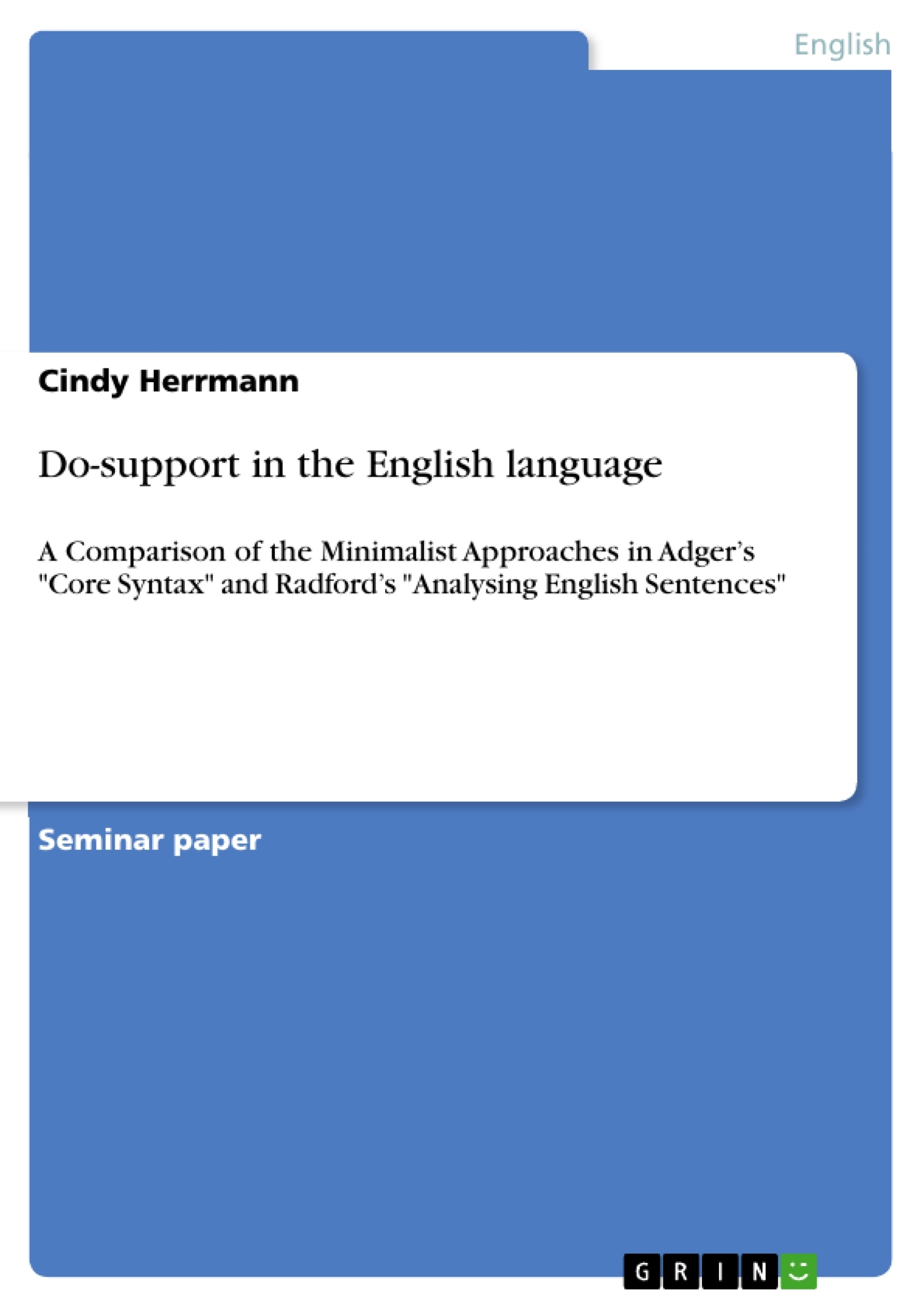The following term paper deals with the two different approaches of the usage of do-support by Adger in "Core Syntax- A Minimalist Approach" and Radford’s "Analyzing English Sentences". The pivotal question “Why and when do we use the do in some cases and in some not?” should be analyzed in this paper. Therefore, the works of both linguists will be regarded in terms of do-support.
We will see that Adger and Radford base their breakdown on Chomsky’s analysis ofauxiliaries in syntactic structures which says that we insert do-support when all other rules fail to apply. Anyway Adger bases his analysis on the so-called Pronouncing Tense Rule (short: PTR). Radford in contrast represents that we always need to attach a verbal affix to an overt verb stem to satisfy the so-called Attachment Condition. If we cannot realize this condition through movement operations like Affix Lowering, do-support needs to kick in.
Adger and Radford both deal with the usage of the do-support in different sentences. First we set up conditions when do-support is necessary and in which cases it is not. Afterwards different sentences will be regarded, always with the question back in mind “Is do-support essential for this sentence to save its grammar?”. Therefore, the theories of both linguists will be contrasted. Finally, we’ll conclude our analysis and sum up our knowledge.
Table of Contents
- Abstract
- Introduction
- Thematic Introduction
- Overview
- Review of Previous Research
- Research Question and Hypothesis
- Economy of Do-Support
- Elliptical Form of the Verb Phrase
- Fronting of the Verb Phrase
- Yes/No Questions
- Affix Hopping onto T in Yes/No- Questions
- Affix Hopping onto V in Yes/No- Questions
- The Usage of Do-Support in Yes/No- Questions
- Negative Phrases and their Syntactic Structure
- Affix Hopping onto V in Negative Phrases
- Do-Support in Negative Sentences
- Negative Interrogative Sentences
- T-to-C Movement in Negative Interrogative Sentences
- Do-Support in Negative Interrogative Sentences
- Infinitives of main verbs in Empathic Sentences
- Infinitives after “Do” in Empathic Sentences
Objectives and Key Themes
This term paper examines the usage of do-support in English sentences, contrasting the approaches of Adger and Radford. It aims to understand why and when do-support is used and how it integrates into different sentence structures. The paper explores the conditions and operations that justify the presence of do-support in various sentence types, including elliptical, fronted, yes-no questions, negative phrases, negative interrogative sentences, and empathic sentences.
- The use of do-support in English sentences
- The economy account of do-support
- Conditions and operations for do-support
- Contrasting approaches of Adger and Radford
- Analyzing different sentence structures
Chapter Summaries
The paper begins by introducing essential conditions and operations that determine the use of do-support, relying on the theories of Adger and Radford. It then examines previous research, laying the groundwork for the research question and hypothesis. Chapter 3 focuses on the economy of do-support, discussing its role in elliptical and fronted sentences. Chapter 4 analyzes yes-no questions, exploring the various affix hopping rules and how do-support functions in this sentence structure. Chapter 5 delves into negative phrases and their syntactic structure, examining the use of do-support in negative sentences. Chapter 6 continues this theme by analyzing negative interrogative sentences, focusing on T-to-C movement and do-support in this sentence structure. Chapter 7 investigates the use of infinitives in empathic sentences, specifically examining how do-support is employed. The paper culminates with a conclusion that summarizes the findings.
Keywords
This term paper focuses on the syntax of English, particularly the use of do-support in various sentence structures. Key themes include the economy account of do-support, the Pronouncing Tense Rule (PTR), the Attachment Condition, Affix Hopping, and movement operations like T-to-C movement and Auxiliary Inversion. The paper also examines different sentence types, including elliptical, fronted, yes-no questions, negative phrases, negative interrogative sentences, and empathic sentences.
- Quote paper
- Cindy Herrmann (Author), 2017, Do-support in the English language, Munich, GRIN Verlag, https://www.grin.com/document/462462




